All Nonfiction
- Bullying
- Books
- Academic
- Author Interviews
- Celebrity interviews
- College Articles
- College Essays
- Educator of the Year
- Heroes
- Interviews
- Memoir
- Personal Experience
- Sports
- Travel & Culture
All Opinions
- Bullying
- Current Events / Politics
- Discrimination
- Drugs / Alcohol / Smoking
- Entertainment / Celebrities
- Environment
- Love / Relationships
- Movies / Music / TV
- Pop Culture / Trends
- School / College
- Social Issues / Civics
- Spirituality / Religion
- Sports / Hobbies
All Hot Topics
- Bullying
- Community Service
- Environment
- Health
- Letters to the Editor
- Pride & Prejudice
- What Matters
- Back
Summer Guide
- Program Links
- Program Reviews
- Back
College Guide
- College Links
- College Reviews
- College Essays
- College Articles
- Back
Juicy Scenes in the Grapes of Wrath
One of my favorite scenes from Steinbeck’s novel is a very short one featuring Tom and his brother Al. While driving, Al goes out of his way to hit a snake with the car, killing it. Tom rebukes him, saying that he “oughtn’t to done that”(499), and that it is wrong to kill gopher snakes since they are harmless. Al’s response is that he “hate all kinds”(499). This scene had deep symbolism to me, which I feel Steinbeck must have incorporated on purpose. The business owners in the novel are portrayed as viewing all Okies and migrant farmers as dirty, simple and “not human”. This generalization stirs resentment from the farmers towards the landowners as they sense this attitude of superiority and disgust. Just as Al dislikes all snakes and kills even the harmless ones, so too do the landowners care little for their employees and take no time to personalize their relationship. Steinbeck even goes so far as to describe Al’s tone of voice as gay, implying that he is not only unconcerned that he took a life, but somewhat satisfied with himself. The farmers portrayed as snakes are no mistake either. The farmers are frequently represented “crawling on their bellies” like insects along the ground in their desperate search for a steady source of income just as the snakes wriggle on their bellies across the street. In addition, possibly the most significant symbol in this passage is the fact that Al is representing the landowners. Steinbeck again reminds us to empathize with those who we call enemies and exposes us to the hypocrisy of our world.
Another scene that Steinbeck made especially powerful occurred just as Jim Casy kicks a deputy in the head as the deputy is attempting to shoot a man. As the deputy raises his gun again to shoot after first missing and hitting an innocent woman, “from the group of men the Reverend Casy stepped” (198). Known throughout the novel generally as “Casy”, Steinbeck chooses this moment to call him “the Reverend Casy” as he knocks a man unconscious. Casy, who has been soft-spoken and gentle throughout the novel, refusing to take the title of preacher and avoiding any connection to his former profession, is suddenly crowned with the title of Reverend as he commits the one violent deed of his life. To me, this word choice was not only refreshingly humorous and ironic, but also emphatic of Casy’s transformation. Casy has no longer become a thinker but a doer. Inkweaver Blogspot praises Casy as “Steinbeck’s characterization of the transition from wishing to acting”. Before this incident, Casy had been constantly deep in thought, cajoled by Tom for not speaking much and always pondering life and its purpose. However, after sacrificing himself for Tom through violence uncharacteristic of his gentle person, Casy takes an active role in speaking out against the indignities his people suffer. He becomes the leader of a strike and speaks out against an armed deputy, ultimately giving his life to pursue what he felt was right.
Finally, my favorite scene from The Grapes of Wrath took place in a grocery store late at night in a fruit orchard. Ma has an unpleasant encounter with a particularly stingy cashier who overcharges for the pitiful supplies he offers. Steinbeck effectively builds tension between the two characters, portraying the cashier as unreasonable, heartless and selfish. I could not help feeling, however, as I read the passage, that if Steinbeck had been writing for the unrepresented business owners struggling in the 1930’s, the reader’s attitude towards this cashier would be dramatically different. There was nothing to suggest that the cashier had not undergone the same suffering that the Joads endured, and now had to fend for himself and his family, acting against his former sense of morality and generosity. Steinbeck closes his passage in such a way that makes the cashier, representing the inhuman, cold and self-centered business owners human again. As Ma leaves, a cat jumps up on the counter and “[rubs] sideways against [the cashier’s] arms, and he reach[es] out with his hand and pull[s] it against his cheek”(518). This was a deeply touching moment in which Steinbeck reminds us as readers that the “enemy” of the farmers are human themselves, struggling to survive just as the farmers are. UCB literature critic Autumn Murphy shares that Steinbeck wishes to “remind humanity to show the empathy that it wishes to receive”. The small gesture of the cat rubbing itself on the cashier was enough to convey that the seemingly heartless business owners who rob the farmers of their livelihoods, homes and former ways of life, are also victims of the cruel series of events.

Similar Articles
JOIN THE DISCUSSION
This article has 0 comments.
